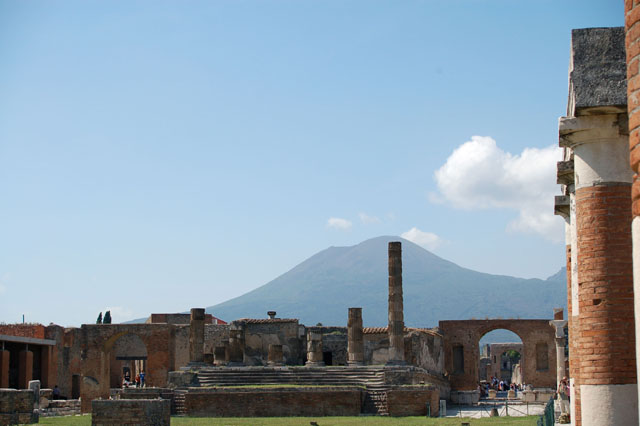One of my most cherished possessions is a pencil-pastel-chalk drawing of Vesuvius as seen from Sorrento. The drawing was made by my grandfather Thomas Newton (or perhaps by his father, my great-grandfather) in 1876, more than 130 years ago. Thomas Newton was an Englishman who brought his wife, son, two daughters, and his mother-in-law to the United States, in 1913. My mother, Beatrice, was born in England in 1913, the youngest of the three children–she was just five weeks old when mother, grandmother, brother, and sister came with her to Oswego, New York.

I grew up seeing the drawing of Vesuvius in my widowed grandmother’s house in Oswego, New York, and then in my parents’ house in Connecticut, where I grew up. My mother and father are gone now, and the picture has come to us. It is old, the paper has darkened over the years, and it is no doubt brittle and fragile. Perhaps we’ll be able to do something to preserve it, and be able to make a good digital copy.
Vesuvius erupted in 1876. Thomas Newton’s drawing shows smoke rising from the volcano in the distance. All during the late winter and early spring, eruptions had been expected, as smoke poured from the volcano, and seismic instruments indicated increasing agitations. The New York Times reported from Naples on 2 February 1876 that the volcano was expected to erupt at any time, possibly interfering with the carnival. On 3 April, the Times reported that the eruption began on 17 March and was expected to be a long one.
It is said that Nietzsche wrote Human, All Too Human at Sorrento in 1876, when he, too, would have seen the erupting volcano. Nietzsche was an inquisitive cultural observer, perhaps prompted by the experience of tourism to some reflections on the scene in which he found himself at Sorrento —
Fashion and modernity. — Wherever ignorance, uncleanliness and superstition are still the order of the day, wherever communications are poor, the landscape is meagre and the priesthood powerful, there we still also discover national costumes. Where signs of the opposite of these are to be discovered, on the other hand, fashion reigns. Fashion is thus to be discovered next to the virtues of present day Europe: could it actually be their shadow-side? — In the first place, male dress that is fashionable and no longer national says of him who wears it that the European wishes to cut a figure neither as an individual nor as a member of a class or nation, that he has made a deliberate quenching of this species of vanity into a law for himself: then that he is industrious and has little time for dressing and self-adornment, likewise that he finds that everying costly and luxurious in material and design accords ill with the work he has to do; finally that through his costume he indicates the more learned and intellectual callings as those to which as a European he stands closest or would like to stand closest: whereas it is the brigand, the herdsman or the soldier who shine through the still existent national costumes as being the leading and most desirable situations in life.
Friedrich Nietzsche, Human, All Too Human, trans. R. J. Hollingdale (Cambridge: Cambridge University Press, 1996), 363.


